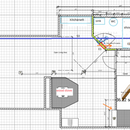Correct all-year-round ventilation for basement (bedroom, kitchenette, bath, laundry) in cold climates (Zone 5)
– I live in Worcester County in Massachusetts (Zone 5)
– The basement comprises of a finshed section that is an open area which serves as a bedroom for my mother-in-law, and an unfinished section that is the laundry room and storage (Total basement size is 930 sqft). See attached document for floor plan and ventilation plan.
– We are adding a bathroom and kitchenette by taking a bit of each section
– I am planning to install an HRV system, dedicated to the basement alone. Initially, the plan was that the HRV will suply air to the open space and pull from bathroom and laundry without a dedicated/local bath fan or bath exaust. Humidistat in bath.
– I’ve heard if not built for the HRV, a bath fan fed into a HRV can ruin the HRV core. Since I do not plan using a bath fan, I’m guessing this does not apply to me
– I’ve also heard that recent Energy star homes requires a local exaust-only bath ventilation despite an HRV. Not that Energy start is my goal, but it has me thinking.
– What I’ve also heard is that an HRV should not be used in the summer (e.g. add to humidity issue)
– Also read fatty air from cooking can damage the HRV core
– Based on the above, it seems that using just an HRV might actually be ok in the winter. Stale cooking air can be filtered with a hood. BTW, there will not usually be major cooking in the kitchenette. Using the HRV in the summer as bath exaust, besides the isue mentioned earlier, might be an overkill and not energy efficient as a whole.
– Initially, was opposed to a bath exaust fan that bypassed an HRV, as I considered this a waste of energy. But to ensure good dehumidification in the summer, and to ensure the bath can be ventilated sufficiently and at anytime, summer or winter, and without causing troubles on the HRV, it seems I am for a local exaust-only bath fan. And perhaps it can be tied in to the kitchenette hood??
– The attached screenshot shows the floor plan and how I plan ducting the HRV. The red squares are registers/dampers.
– What is the right way to ventilate this basement in an energy efficient, sustainable way?
– What should be done, what should run, and how in the winter and in the summer?
– It’s been said an HRV system is the right thing for this climate zone, but is it for this basement, or is an ERV a better choice?
– What’s the best way to ventilate the bath and kitchenete with the presence of a balanced system (e.g. HRV)?
– Are twin systems HRV/ERV combination products the solution?
Additional Details:
Architecture/HVAC: Post and beam construction; Electric baseboard and woodstove (No HVAC system)
Line, blue: supply duct, HRV
Line, red: exaust duct, HRV
Arrow, Blue: Fresh air suply/flow
Arrow, Orange: Stale air flow
Rectangle, red: Register/dampler for exausting stale air
Rectangle, purple: HRV
Line, green: new wall/door
HRV: heating recovery ventilator
ERV: energy recovery ventilator
GBA Detail Library
A collection of one thousand construction details organized by climate and house part










Replies
George,
It's perfectly OK for an HRV system to pull exhaust air from a bathroom. That's normal. However, you shouldn't pull exhaust air from a kitchen range hood. (The range hood should be separately exhausted to the exterior.) It's OK to pull some exhaust air from the kitchen ceiling if you want, as long as the exhaust grille isn't too close to the range.
As long as your local building inspector approves, you don't need a separate bathroom exhaust fan -- assuming that your HRV system can pull exhaust air from the bathroom.
An ERV or HRV will tend to lower indoor humidity levels in the winter, but may increase the indoor humidity load (the latent load) during the summer. If you are worried about indoor humidity during the summer, you may want to use an air conditioner or dehumidifier during the summer months.
It's perfectly OK to run an ERV or an HRV year round, as long as you understand the equipment's limitations and purpose.
For more information on these issues, I suggest that you read:
Designing a Good Ventilation System
HRV or ERV?
Thanks Martin. That was very helpful.
Another question I forgot to raise earlier is, how far in should the supply duct go. In the drawing provided, I brought it to the extreme end of the open area plus make a 90 deg turn to the middle. While this might lead to good circulation, it could have a negative impact on the flow as well (turn and length).
How does one calculate the optimal position? Would it be ok to eliminate the turn, or even bring the supply to just the middle of that side wall and not all the way to the end?
George,
You should deliver your supply air to the locations where you want the air delivered. If you are worried about pressure losses due to the long ductwork and the fittings, you can make your duct diameter larger. The fewer elbows, the better.
Consult the instructions that accompany your HRV for more information on duct sizing.
You may also want to read this article: Installing a Heat-Recovery Ventilator.